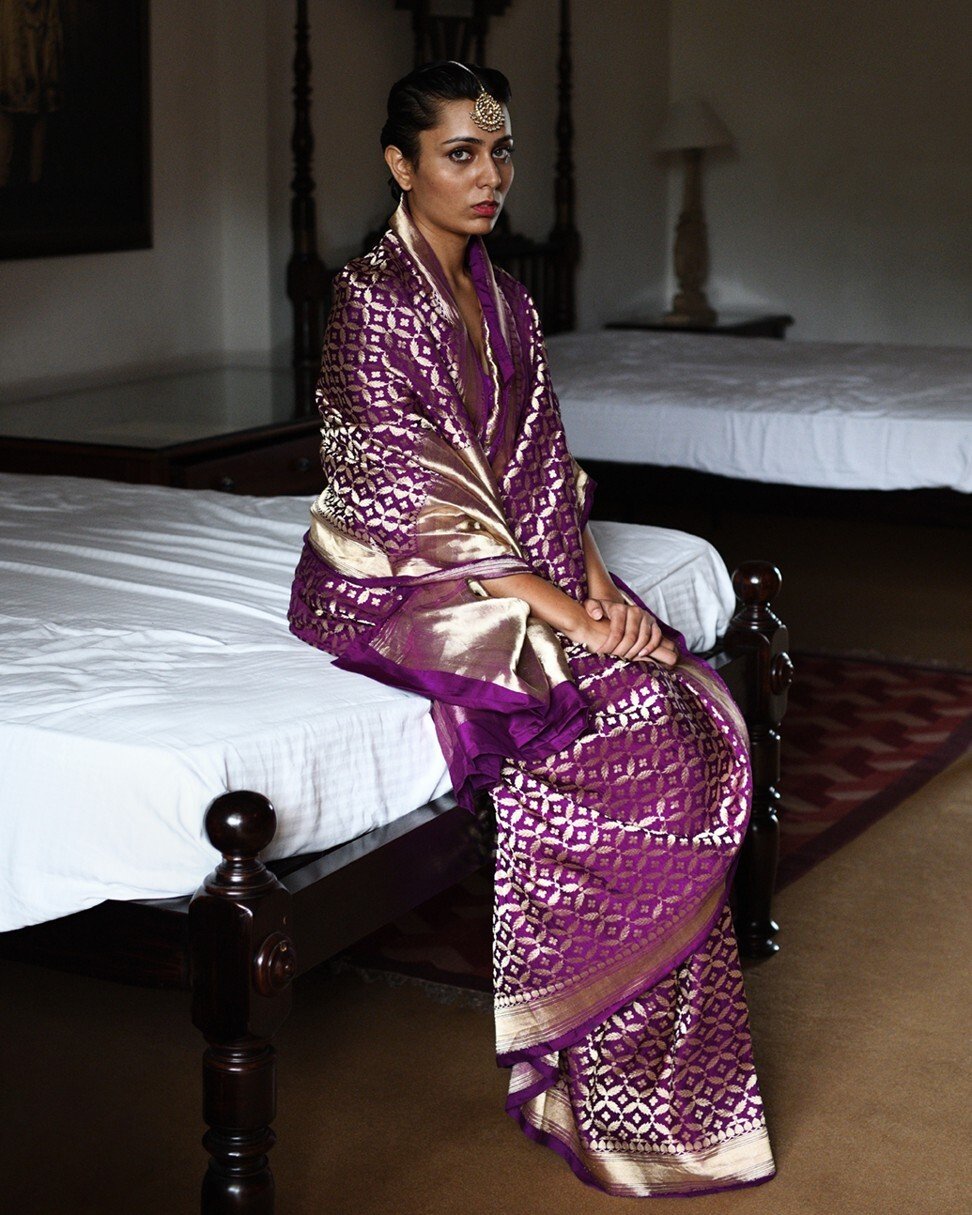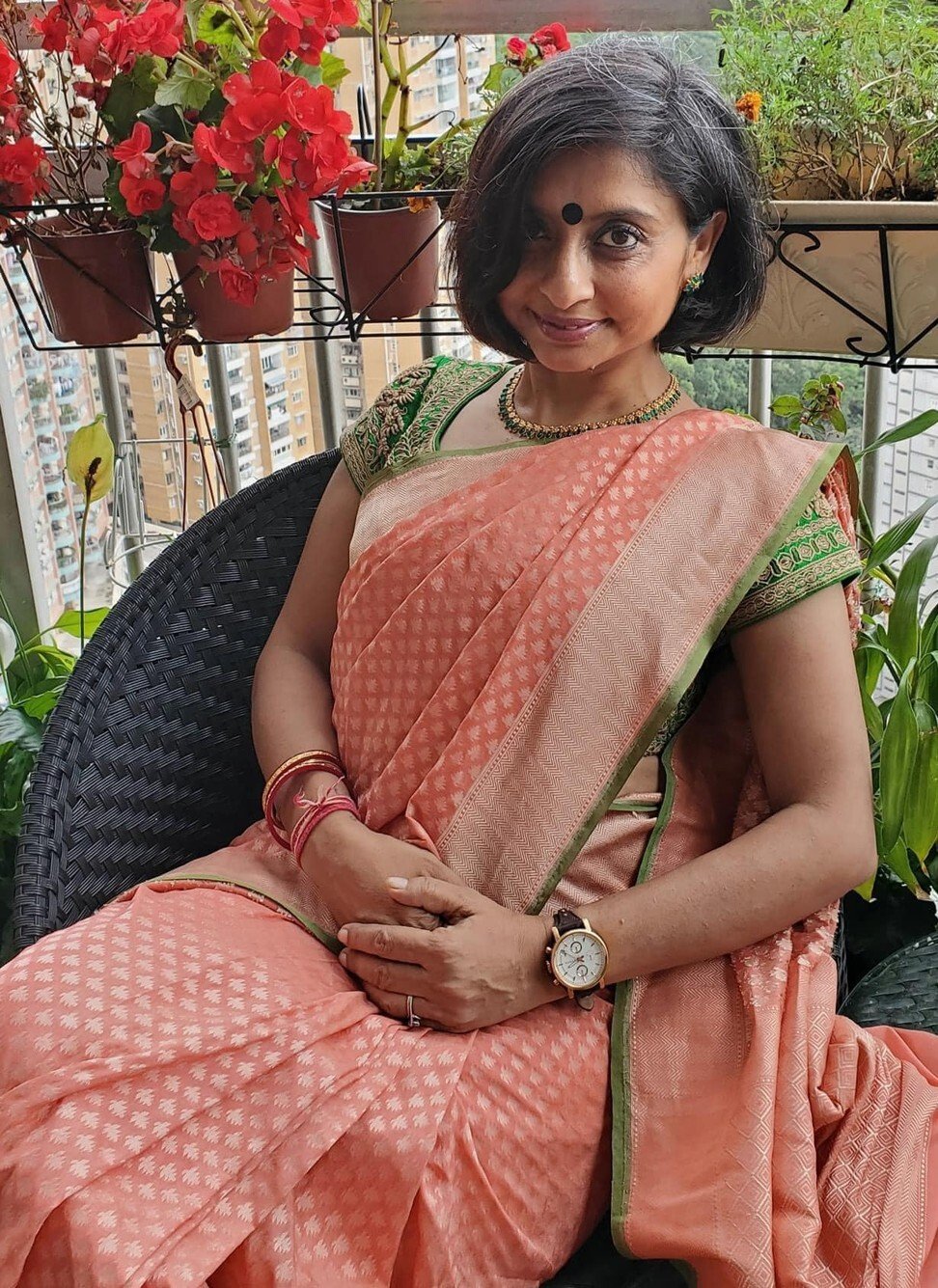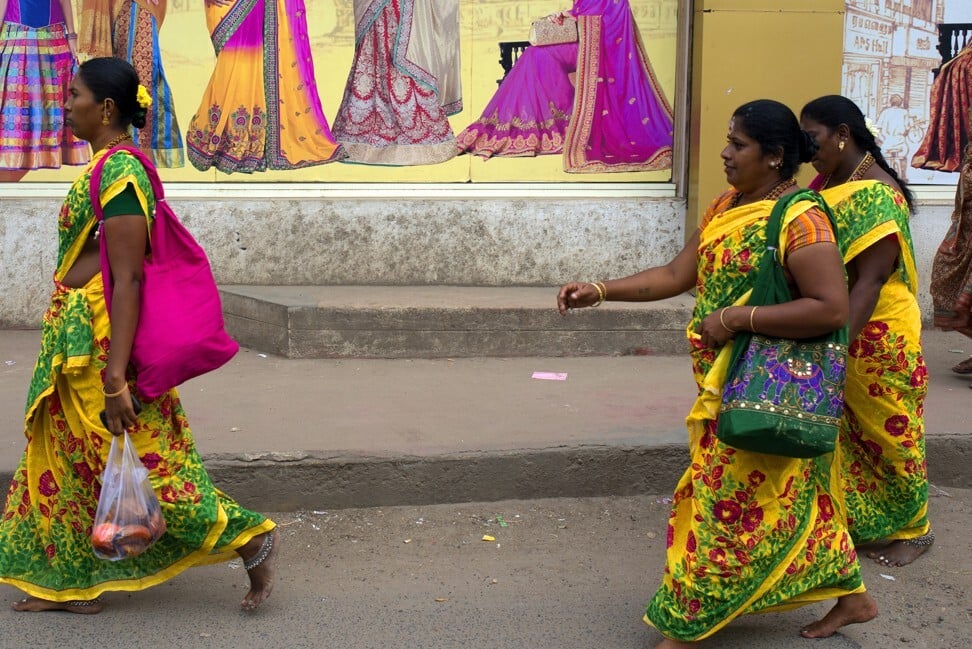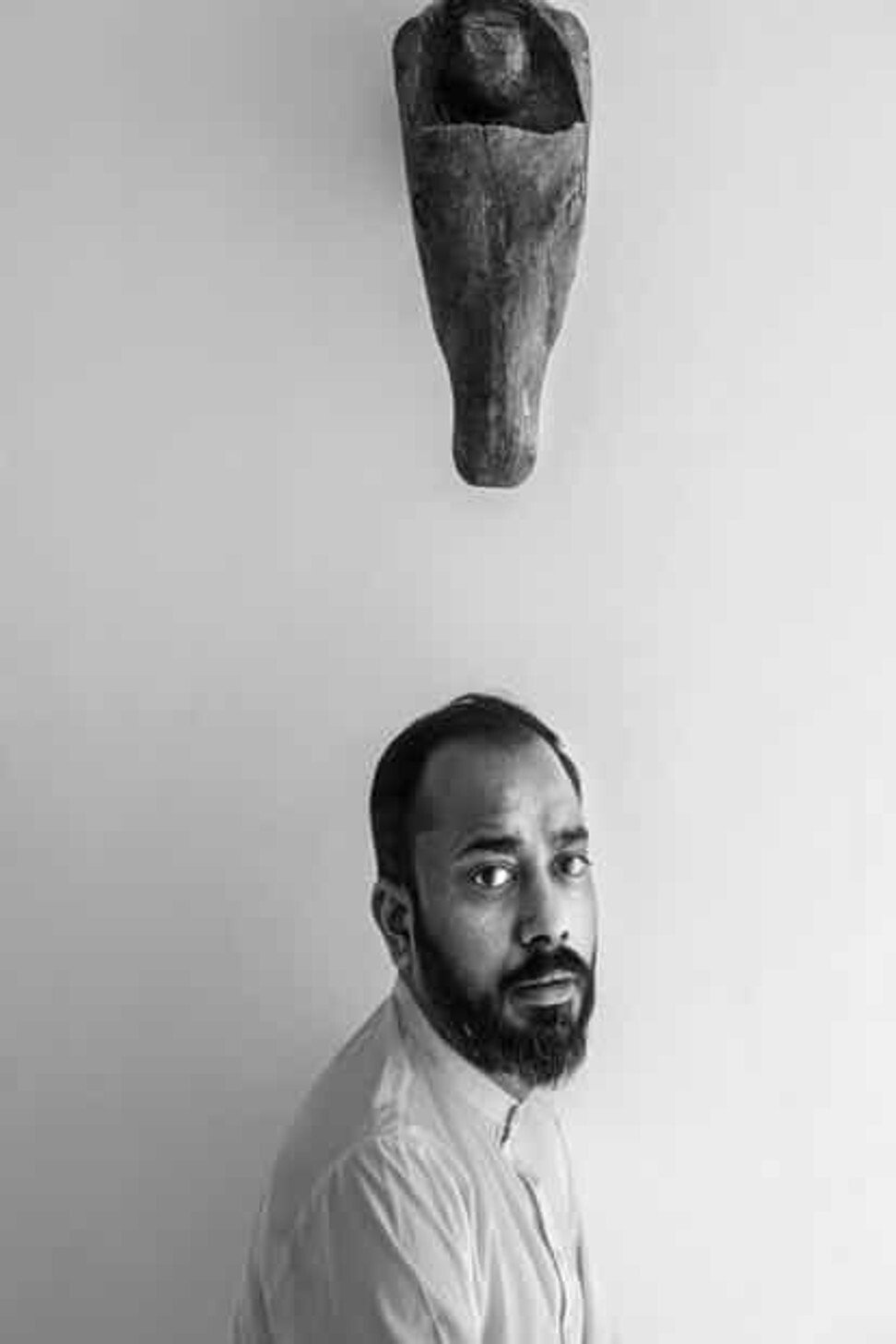
Explainer | History of the sari, from ancient India to fashion runways – simple, versatile garments tell the stories of women who wear them
- Unstitched and six to nine metres long, the sari has been traced to the Indus Valley in 2800BC. Worn by rich and poor alike, there is a sari for every occasion
- How saris are made and worn varies depending where in India you go, with the cheapest costing US$7 and the finest 4,000 times more
That a long, unstitched rectangular garment used to drape the female form for 5,000 years and worn every day by hundreds of millions of women from the Indian subcontinent flourishes as a fashion choice of the 21st century woman makes the story of the sari a fascinating one.
The earliest records of a garment similar to the sari can be traced back to the Indus Valley Civilisation that flourished between 2800 and 1800BC in what is today northwest India. The word “sari” is believed to be derived from a Sanskrit word meaning “strip of cloth”.
It originally formed part of a three-piece costume consisting of a piece of cloth draped as a lower garment, a chest band, and another piece of cloth worn over the shoulder and used to cover the head.
“The sari is probably the oldest unstitched attire in existence. It is the most versatile garment and is both conventional and contemporary,” says Delhi-based Sanjay Garg, the owner and designer of Raw Mango, a brand of contemporary handwoven textiles. A sari designed by Garg, 40, featured in an exhibition at New York’s Museum of Modern Art in 2017 of 111 articles of clothing and accessories that have left an indelible mark on modern fashion.

Six to nine metres in length, the sari is seen on catwalks, in Bollywood movies, and on the streets of rural and urban India. Worn by women from all walks of life, it epitomises grace and timeless elegance.
To Aradhana Chandra, a special needs educator and Hong Kong resident from Bijnor, in India’s Uttar Pradesh state, the sari is much more than a piece of clothing. It is a repository of her family history and a reminder of who she is.
History of chicken tikka masala: loved in Britain, ignored in India
“My love of saris comes from my mother. It is probably the only garment that I ever saw her wear. There was a sari to sleep in, a sari for household chores, a sari to wear to the bazaar and a sari to wear to weddings,” says Chandra, 52, who was inspired to create a Facebook platform called “Sari Sisters Hong Kong” for women in the city to share stories about the garment.
“After moving to Hong Kong, I started wearing the saris that my mother had given me as a part of my wedding trousseau. Hand-woven saris from different parts of India – the brocaded Banarasi from Varanasi, the pure silk Kanjeevarams from Tamil Nadu, the Paithani from Maharashtra and so many more.”
“The sari gives me a sense of belonging,” says Bangalore-based perfumer Ahalya Matthan, who in 2016 founded The Registry of Sarees, a research and study centre for handspun and handwoven saris in India.

“My fondest childhood memories were going sari shopping with my mother and grandmother. I was fascinated by the endless shelves piled with neatly folded, colourful saris, entertained by the salespeople, who were always men, unfolding and draping the whole sari on themselves, and educated by the haggling over the prices while countless cups of coffee were consumed.”
When Matthan received a gift of 47 Kanjeevaram silks from her ailing grandmother, she was inspired to start the “100sareepact”, a social media movement, along with 52-year-old Anju Maudgal Kadam, which encourages women to wear saris and share their stories online.
“I wanted to honour my grandmother and the saris that she had collected and worn over a lifetime,” says Matthan.

The popularity of the sari has a great deal to do with its versatility. “The sari can be draped in nearly a hundred ways, allowing the wearer to style it so as to look formal or casual. Most of the drape styles are specific to different regions of India and, just like the food and regional languages, are a result of context, geography and function,” explains 39-year-old Malika Verma, co-creator with Rta Kapur Chishti, 72, a sari historian, textile scholar and co-author of Saris: Tradition and Beyond, of the “The Sari Series”, a series of 84 short films documenting India’s regional sari drapes.
“We wanted to reintroduce regional ways of draping saris into contemporary Indian fashion and make the garment more accessible to the urban Indian woman. Traditionally saris were worn without blouses and most of the drapes do not have a petticoat [a long underskirt worn under the sari],” Verma says.
The modern urban style of wearing the sari has the garment draped around the waist a few times, pleated and tucked into the waistband of a petticoat with the loose end of the fabric, called the pallu, going across the torso and draped elegantly over the left shoulder. It is worn with a matched, fitted blouse that traces its roots to the Parsee community of India.

“The style was popularised in the 1870s by a Bengali lady – Jnanadanandini Devi … She adopted the front pleat style of wearing the sari from the Parsee women she had seen in Bombay, and wore it with a blouse and petticoat, as they did, which was different from the traditional Bengali style of wearing the sari,” says Chishti, who started a “Sari School” in 2009 in Delhi, and conducts workshops on the sari and the different methods of tying them.
“The blouse is also an adaptation by the Parsees, from the Western puffed sleeve blouse they wore over the long skirt. Though they had come from Persia 700 years earlier, they adopted the sari as they sought asylum in India on the condition that they would wear the local dress, adopt the local food habits and the local language of the western state of Gujarat.”
The sari shows the rich diversity of Indian dyeing, printing and silk weaving.
Kanjeevaram silk saris … use a special weaving technique that makes the sari last for generations … The sari has golden weaves and bold, colourful motifs like flowers, peacocks and elephants
“Each region brings forth a trunk full of saris, with a strong identity and their own traditional designs, motifs, and colours,” says 73-year-old Laila Tyabji, co-founder of Dastkar, an NGO established in 1981 that supports traditional Indian craftspeople.
“Even from village to village, there is a different weave. Every sari has a story about the society and the people around it. It is a history book that tells you about the region, the community, the craftsmen, and the geography of the place.”
The famous brocades from the ancient city of Banaras, with intricate designs and detailed embroidery using gold and silver threads, take their name from the city and evolved during Mughal rule over India. To this day a Banarasi sari is a must-have in an Indian bride’s trousseau.

“Kanjeevaram silk saris originate from Kanchipuram, a temple town in Tamil Nadu, and use a special weaving technique that makes the sari last for generations. The saris have contrasting bright colours with designs of the border and the pallu being different from the body of the sari. The sari has golden weaves and bold, colourful motifs like flowers, peacocks and elephants,” says 71-year-old Deepa Sharma from Delhi, who owns Arankri, a 30-year-old establishment that curates handcrafted saris.
“The Baluchari saris from West Bengal incorporate designs based on mythological stories from the great Indian epics, the Ramayana and the Mahabharata.
“Tussar saris from the state of Bihar are very soft and valued for their rich texture and natural deep gold colour. The Sambalpuri saris from Orissa are famous for the tie-dye art reflected in their intricate weaves, known as “ikkat”. The threads are tie-dyed first and then woven into a fabric.”

A factory-made cotton sari can cost as little as 500 rupees (US$7), while a handcrafted sari that takes anywhere from a few weeks to a few months to make can cost upwards of 200,000 rupees. The most expensive sari was sold for 3.93 million rupees in 2008.
Made by The Chennai Silks, a sari manufacturer from Tiruppur, a city in Tamil Nadu state, it had reproductions of 11 paintings by Indian artist Raja Ravi Varma interwoven in the garment. It finds a mention in Guinness World Records as the most expensive sari ever sold.
Over the past few decades, the demand for cheaper saris has made power-loom saris popular, making it difficult for hand weavers to compete. However, of late, handloom weaves are being reinterpreted in contemporary designs, and forgotten craftsmen are making a comeback.

“Textiles, just like with everything else, will continue to evolve as time passes. However, a ‘revival’ needs to go beyond just a trend, and instead grow organically and sustain a momentum,” says Garg, whose work on the Mashru fabric (a handwoven mix of cotton and silk) over the past decade has led to a revival of the textile.
A handmade sari is a testament to the skill and creative genius of the mostly rural artisanal families that make them. Techniques and expertise have been passed down in these families from generation to generation over centuries. The more intricate silk saris take many weeks to make.
“A weaver of Kanjeevaram saris once who told me how he passes his blessings to the wearer of the saris he creates. He wishes the bride who wears it the strength of the elephants, the grace of a gazelle and a life of abundance represented by the trees, as he weaves each of these into his creations,” says Kadam.

A beautiful sari is a living, breathing and enduring piece of art. It holds in its folds the history of an entire subcontinent, the skill of its craftsmen and the memories of the women who lovingly cared for it for the next generation.

